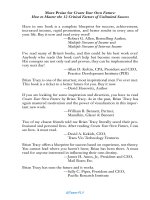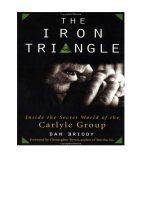John wiley sons endurance winning lifes majors the phil mickelson way mar 2005 tlf
Bạn đang xem bản rút gọn của tài liệu. Xem và tải ngay bản đầy đủ của tài liệu tại đây (1.78 MB, 224 trang )
Endurance
OTHER BOOKS BY DAVID MAGEE
The John Deere Way: Performance That Endures
Ford Tough: Bill Ford and the Battle to
Rebuild America’s Automaker
Turnaround: How Carlos Ghosn
Rescued Nissan
❖
Endurance
WINNING LIFE’S MAJORS THE
P H I L M I C K E L S O N WAY
David Magee
John Wiley & Sons, Inc.
Copyright © 2005 by David Magee. All rights reserved
Published by John Wiley & Sons, Inc., Hoboken, New Jersey
Published simultaneously in Canada
Design and composition by Navta Associates, Inc.
No part of this publication may be reproduced, stored in a retrieval system, or transmitted in any form or by any means, electronic, mechanical, photocopying, recording, scanning, or otherwise, except as permitted under Section 107 or 108 of the
1976 United States Copyright Act, without either the prior written permission of the
Publisher, or authorization through payment of the appropriate per-copy fee to the
Copyright Clearance Center, 222 Rosewood Drive, Danvers, MA 01923, (978) 7508400, fax (978) 646-8600, or on the web at www.copyright.com. Requests to the Publisher for permission should be addressed to the Permissions Department, John
Wiley & Sons, Inc., 111 River Street, Hoboken, NJ 07030, (201) 748-6011, fax (201)
748-6008, or online at />Limit of Liability/Disclaimer of Warranty: While the publisher and the author have
used their best efforts in preparing this book, they make no representations or warranties with respect to the accuracy or completeness of the contents of this book
and specifically disclaim any implied warranties of merchantability or fitness for a
particular purpose. No warranty may be created or extended by sales representatives or written sales materials. The advice and strategies contained herein may not
be suitable for your situation. You should consult with a professional where appropriate. Neither the publisher nor the author shall be liable for any loss of profit or
any other commercial damages, including but not limited to special, incidental, consequential, or other damages.
For general information about our other products and services, please contact our
Customer Care Department within the United States at (800) 762-2974, outside the
United States at (317) 572-3993 or fax (317) 572-4002.
Wiley also publishes its books in a variety of electronic formats. Some content that
appears in print may not be available in electronic books. For more information
about Wiley products, visit our web site at www.wiley.com.
Library of Congress Cataloging-in-Publication Data:
Magee, David, date.
Endurance : winning life’s majors the Phil Mickelson way / David Magee.
p. cm.
Includes bibliographical references.
ISBN-13 978-0-471-72087-4 (cloth)
ISBN-10 0-471-72087-9 (cloth)
1. Golfers—Psycholgical aspects. 2. Golfers—Conduct of life. 3. Mickelson, Phil,
1970- I. Title.
GV979.P75M34 2005
796.352’092—dc22
2004030893
Printed in the United States of America
10 9 8 7 6 5 4 3 2 1
For my brother
I always believed I was going to win eventually.
—Phil Mickelson
Contents
Introduction
1
2
3
4
5
6
7
8
9
1
Following Dreams (and Talent)
7
Beating the Pros
33
Managing High Expectations
53
Facing a Lurking Tiger
73
Dealing with Defeat
91
Setting Priorities
109
Enduring Tough Times
131
Mastering the Moment
157
Savoring Victory
177
Acknowledgments
197
Appendix 1: Phil Mickelson’s Road to Major Victory
199
Appendix 2: Phil Mickelson’s PGA Tour Results
201
Notes
209
ix
Introduction
As one of the five clubs that founded the United States Golf
Association and with the first and oldest clubhouse in the
United States (opened in 1892), Shinnecock Hills in
Southampton, New York, is America’s version of St. Andrews,
a links course bathed in beauty and rock-hard difficulty colored most brilliantly by its rich history. Rugged, with its
nearly treeless layout and windswept proximity to the nearby
Atlantic Ocean and Peconic Bay, Shinnecock Hills stands as
a quiet but strong monument of days gone by.
In 2004, however, Shinnecock Hills was a catalyst in canonizing a hero of modern golf. It began the moment Phil
Mickelson stepped to the first tee on Thursday for the 104th
U.S. Open, receiving a raucous applause from fans in the
New York crowd of almost thirty-five thousand, and did not
end until the moment he reached the clubhouse after finishing the 18th hole on Sunday.
With each hole played during the four-day event, the
1
Endurance
fans’ support of Mickelson escalated. By late in the second
round, when he surged to the top of the leader board en
route to shooting a 4-under-par 66, repeated calls of “PHIL!”
and outward passion from the gallery directed toward the
left-handed, smiling player reached a frenzied pitch. So boisterous was the crowd with Mickelson that one sportswriter
later wrote that he “heard one roar Sunday and figured they
had just announced Jonas Salk on the tee.” It became obvious to most spectators, television viewers, and leading analysts that something new and interesting in the game of golf
was afoot.
Phil Mickelson would finish second to Retief Goosen at
the U.S. Open at Shinnecock Hills. Despite his valiant play
and the adrenaline provided by thousands of screaming and
encouraging fans, Mickelson walked off the course of a
major for the forty-seventh time in forty-eight tries without
the winner’s trophy. But the New York tournament was far
from a loss for Lefty. Two months before, Mickelson had
proven he could win a major with a thrilling victory at the
Masters, ending more than a decade of despair in big tournaments. Second place was not so bad this time because it
was only a difficult loss, not a continuation of something
much larger than the event.
In defeat, his career reached a plateau attained in previous generations only by such golf greats as Arnold Palmer
and Jack Nicklaus. Arnie developed an army of followers
through his likable ways and is the major reason golf became
the game it is today. Nicklaus kept them coming back for
more. Sure, Tiger Woods charged up crowds at unseen levels
during his major run. Mickelson, even, had experienced
2
Introduction
years of growing, unusually vocal fan support as he emerged
as one of the game’s top young stars, fighting for more than
a decade to win a major tournament.
But no golfer of this era had experienced the mass level
of support and passion shown to Mickelson in 2004 at America’s championship of golf at Shinnecock Hills. The old club
crowned a contemporary favorite of the game, and nobody
was more gracious and pleased than Phil Mickelson, who
smiled, waved, signed autographs, and exalted in the royal
treatment, even as Goosen tightly held the winning cup.
Few athletes come along in a lifetime with an ability to
capture the spirit and embrace of the majority of sports
fans as has Phil Mickelson, for the simple reason that the
combination of attributes needed to appeal to most is so
rare.
It takes talent, which Mickelson obviously has. As an amateur, he had the best career since Jack Nicklaus, winning
youth, collegiate, and amateur tournaments at the highest levels. Mickelson was named to the collegiate All-America team
in his first season at Arizona State University, and by
the time he turned professional in 1992 he had won such
events as the coveted U.S. Amateur. Including a PGA Tour win
as an amateur, Mickelson had won twenty-three times on the
world’s most difficult professional circuit by the end of 2004
and had claimed almost $30 million in prize money. When fellow players and golf analysts talk about Mickelson’s abilities,
most are quick to point out that few players in the game possess the skills he has, blending power with finesse and creativity. He can easily drive the ball 300-plus yards or hit a
backwards flop shot over his head onto the green if necessary.
3
Endurance
Perhaps the best example of Mickelson’s talent came
during his final event of 2004. Playing in the PGA Grand Slam
of Golf, a two-day tournament for champions of the season’s
majors held annually in Hawaii, he carded his lowest round
ever as a professional, posting a 59 to easily win the tournament. Because the event was not officially part of the PGA
Tour, it did not count in the record books, but in equaling
the lowest-ever competitive rounds of 59 by Al Geiberger,
Chip Beck, and David Duval, Mickelson showed he is one of
the best players in golf, with an ability to make birdies by the
bunches at any given time.
There are other talented players on the PGA Tour fighting to win every week out, however, including the likes of
Vijay Singh, Tiger Woods, and Ernie Els. Nobody questions
the talent these men possess, yet one has to wonder what
gives Mickelson a decided advantage over them with fans
when it comes to on-course popularity.
A reasonable assumption is that it takes personality in
addition to talent. Mickelson has always got that smile, a
wave for the fans, and a willingness to sign autographs. But
there are countless players on tour vying for our attention
each week who are likable and approachable enough.
No, the athlete who occasionally breaks from the pack as
has Mickelson and defines a new era has something more
than talent and personality. Those are vital characteristics,
but alone they are not enough. To become the most popular player of an era, an athlete must have qualities and style
in his or her game that people relate to in their everyday
lives, making them feel as if their own struggles are on the
line when they are pulling for their favorite.
4
Introduction
For Mickelson, his endurance of the game through difficult times and his ongoing battle for so many years to win
the big one have uniquely endeared him to fans. People pull
for Mickelson because they relate to him. He’s fighting the
same battles on the course that they are fighting in their
lives, every day. Or, as one sportswriter stated, Phil Mickelson is “everybody’s brother, son or father.”
He’s got a little paunch, and usually a goofy grin on his
face, but he’s got fierce game, and he’s always competing,
trying to find a way to get on top. The total package makes
him the everyman to American sports fans, elevating Mickelson to what golf analyst Johnny Miller said while witnessing the head-turning affection showered on the golfer at
Shinnecock Hills is status as the most popular golfer of
modern times. How Phil Mickelson reached this pinnacle
and what the journey teaches his fans are the cornerstone of
this book, the lessons learned from his game and his career
that can benefit all in their daily and ongoing struggles to
win life’s majors.
5
1
❖
Following Dreams
(and Talent )
B
Breaking from conventional wisdom with those we teach,
work with, and guide in our daily lives is not always the easiest task. It is certainly easier, and seemingly much safer, to
play the odds and lead by expecting and demanding that
tasks be done as they’ve always been done. But Phil Mickelson and perhaps, more importantly, his father are testaments that the courage to give natural talent, headstrong
commitment, or both a chance to succeed can yield great
results.
Less than 5 percent of the golfers in the world play from
the left side of the ball despite a left-handed population that
is three times that number, and until the success of Mike
Weir and most recently Phil Mickelson in the majors, the
world’s biggest professional golf tournaments were almost
never won by lefties. It was an act of faith in talent, then, that
Phil Mickelson’s father followed his instincts and let his
young son swing the golf club from the “wrong” side of the
9
Endurance
ball, because the world’s most famous left-handed athlete
isn’t actually left-handed at all. He just plays golf that way.
Born on June 16, 1970, in San Diego, California, Philip
Alfred Mickelson writes right-handed, throws a ball righthanded, and eats right-handed. Yet he’s one of just seven
left-handed players to ever win on the PGA Tour (he owns
twenty-three of the thirty-nine wins) and is well known by
fans with the nickname “Lefty.” How Phil Mickelson began
playing as a left-hander dates back to the earliest months of
his life.
Mickelson’s parents both loved sports. His mother,
Mary, was a good basketball player as a young lady at Our
Lady of Peace High School in San Diego and is noted by
friends and family for her competitive spirit. His father, Phil
Mickelson Sr., was a navy and commercial pilot with a singledigit handicap and a ferocious hunger for golf. The Mickelsons already had a child, one-year-old daughter Tina, when
Mary Mickelson was pregnant again in 1970. Due to the family’s impending growth, Phil and Mary Mickelson went in
search of a house to buy. In a new subdivision in San Diego,
they found a modest house that had one characteristic that
intrigued the couple: the lot was oddly shaped and abnormally larger than others in the neighborhood. They could
have found a bigger house, but none for the price had the
benefit of such a big yard. With one child already and
another on the way, Phil and Mary Mickelson made a calculated bet that a big yard was more important than a house
with greater style. The decision would play a significant role
in the family’s future.
When their first son was born, Phil and Mary sent out
10
Following Dreams (and Talent)
birth announcements to friends and family that stated “the
Mickelson foursome was now complete” and included a picture of the baby being posed on the nose of an airplane.
When Mickelson was three months old, he got his first golf
club, as a gift. The idea of giving such a tiny baby a golf club
goes against the natural tendencies of many parents. It
might be fitting, perhaps, for Peyton Manning to lay a football in the crib beside a newborn son, but Phil Mickelson Sr.,
pilot, giving his infant child a golf club?
Learning Is Observing
Whatever he was thinking, it worked. Just more than a year
later, an eighteen-month-old Mickelson would join his father
in the big yard of the family’s San Diego home for a little
practice time. Just call it an apprenticeship in the extreme
degree: father swinging, child watching, child imitating. All
the lessons from professionals given years down the road
could never duplicate or replace what occurred in Mickelson’s oddly shaped backyard with father teaching eager-tolearn son.
For a good view and also for safety reasons, Mickelson
would stand adjacent to his father, carefully watching his
smooth, right-handed swing. Mickelson began to grip his
own club and take it back and swing, just as his father did.
Mirroring his father made Mickelson’s swing left-handed,
however.
“He would stand in front of me,” Phil Mickelson Sr. said,
“and draw back the club, like a left-hander, and hit it with the
back of the club. He hit the ball awfully good.”
11
Endurance
Since Mickelson’s club was right-handed and the child
appeared to be right-handed in everything else he did, his
father tried setting him up in his footsteps, on the right side
of the ball, so he could strike it properly. But just before
swinging, the toddler would turn around, regrip the club,
and take a big swing from the left side of the ball. Mickelson’s club was a homemade, cut-down junior 3-wood.
“He was watching me swing right-handed,” Mickelson’s
father recalls. “He was hitting the way he saw me hit it. It was
a right-handed club, so I kept turning him around, and he
kept turning back to left-handed.”
It’s long been known that children learn from their parents both good and bad by observing their actions, but it
often does not hit home with full clarity. Nobody illustrates
this clearer than Mickelson and his father, though, serving as
a powerful reminder that even the smallest of children are
acutely aware of what their parents do and how they do it.
By emulating his father, Mickelson created his own swing,
albeit backward. It was just like his father, but in mirror
image reverse. When his father tried showing him the “right”
way to swing the club, it appeared wrong and the young
Mickelson would have nothing of it.
Left Is Right for Some
This is the point in an unconventional situation when many
parents, coaches, or business managers would throw in the
towel and demand a switch to the more conventional side of
getting things done. The clubhead was taking a beating as the
youngster continually smacked the ball on the back of the
12
Following Dreams (and Talent)
face. Why let the child ruin his club when he could just force
him to hit from the same side of the ball used by almost
everyone else in the world? His father, though, shaped the
clubhead so his son could continue playing left-handed and
never again tried to turn him into a right-handed golfer.
“Remarkably,” Phil Mickelson Sr. said, “he seemed comfortable and he wasn’t swinging that badly, so I decided I’d
just change the golf club rather than the swing.”
Letting his son swing left-handed, when the vast majority of golfers in the world are right-handed and his son was
naturally right-handed as well, was a fortuitous decision for
the elder Mickelson. By allowing him to follow his natural
instinct, Phil Mickelson Sr. unleashed a passion for the game
of golf in his young son.
With a toddler’s blond hair and smiling disposition,
Mickelson carried his patchwork club, held together with
electrical tape, around with him just like other children his
age carry around a favorite toy or a security blanket. And he
used it at every opportunity. Mickelson’s father placed a
golf cup in a hole in the ground in the family’s large backyard
and cut the grass around it down short so it resembled a
green. He made a tee box so his children could hit balls to
the target. The toddler followed his father around with his
golf club constantly, so much so that the grass was worn to
the dirt. As Mickelson’s motor skills developed, his golf
swing evolved at the same time, resulting in a natural and
balanced stroke for the youngster.
The father’s passion for the game rubbed off on his son
at an age when most children his age had not moved beyond
blankets, blocks, and large, soft round balls. When pictured
13
Endurance
in a family photo at age two, Mickelson is dressed up in knee
socks, black shorts, and a double-buttoned, candy-striped
white sweater, but in his left hand is a golf ball and in his
right hand is his favorite golf club.
“That club,” Phil Mickelson Sr. said, “went with him
everywhere he went. It was like his teddy bear. As long as it
was next to him, he was ready to go to sleep.”
Mickelson’s father not only gave in to his son’s lefthanded golf tendency, but he also fueled his desire by providing him tools to practice his favorite trade. By the time
Phil Jr. was three, his father had handcrafted him a small set
of sawed-off left-handed golf clubs. With his own bag, the
youngster was eager to go where his father went on the
weekends, beyond the small thirty-five-yard hole in his yard
to a real golf course with full-size holes. When told no, he
and a friend ran away from home, in search of a golf course.
Mickelson had his favorite club in hand.
“He’d ask the neighbors for directions,” his father said,
“and they kept directing him to turn right. He kept following their directions, and, of course, he ended up back in
front of the house.”
Instead of getting mad and punishing his wandering
way, Mickelson’s father realized his son had an unusual
hunger for golf and that it was his passion and likely his talent. He was trying to push outside his boundaries because
it was his natural desire. It was not a matter of escaping
boundaries as much as it was an innate desire to explore new
and natural ones.
His young son’s point was made, and his father realized
that the three-year-old was serious about getting onto a golf
14









